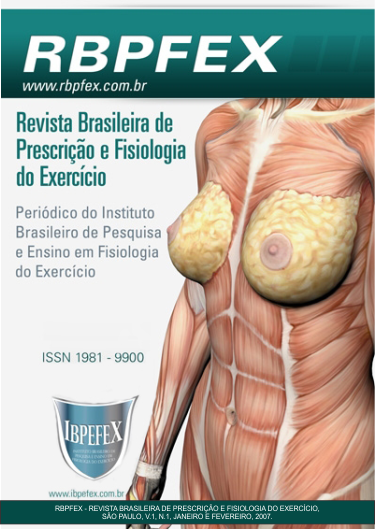Prevalence of obesity in women iniciating a exercise program in a fitness center of Florianópolis
Abstract
Obesity is a problem that comes quite frequently being argued for health care professional. There are several forms to classify obesity. In the present study, Body Mass Index (BMI) and the Percentage of body fat were utilized. Our aim was to verify the prevalence of obesity in a sample of females initiating a fitness center exercise program. The sample was composed of 186 women with age among 18 and 51 years. The results demonstrated that only 16% of women posses BMI greater than 30Kg/m2, however, this changed when the method of classification utilized was the percentage of body fatness. In this case, 65% of the sample was classified as obese. It was verified still, that 59% of the women with IMC below of 30Kg/m2 are classified as obese by the amount of corporal fat. This lack of correlation between the two parameters reflects the limitation of the BMI in discriminate between fat mass and body free fat mass. Spite the excess of fat, many women presented a propel weight for stature. Maybe, this could be explained by their reduced level of muscle mass. Together, our results confirm the inability to describe obesity in a specific population by the use exclusive of BMI.
References
Nahas, M.V. Obesidade, Controle de Peso e Atividade Física. Londrina: Midiograf, 1999.
Cabral, P.C.; e colaboradores. Avaliação antropométrica e dietética de hipertensos atendidos em ambulatório de um hospital universitário. Rev. Nutr., v. 6, n. 1, 2003.
Gus, M.; e colaboradores. Associação entre diferentes indicadores de obesidade e prevalência de hipertensão arterial. Arq. Bras. Cardiol., v. 70, n. 2, 1998.
Fernández-Real, J.M.; e colaboradores. Body mass index (BMI) and percent fat mass. A BMI > 27,5Kg/m2 cuold be indicative of obesity in the Spanish population. Med. Clin., v. 117, n. 18, p. 681 – 684, 2001.
Fernandes Filho, J. A Prática da Avaliação Física. 2. ed. São Paulo: Shape, 2003.
Costa, R.F. Composição Corporal: teoria e prática da avaliação. São Paulo: Manole, 2001.
McArdle, W.D.; Katch, F.I.; Katch, V.L. Fisiologia do Exercício: energia, nutrição e desempenho humano. 4. ed. Rio de Janeiro: Guanabara Koogan, 1998.
Michels, G. Aspectos antropométrios de escolares de 10 a 14 anos de Córdoba y província. Tese (Doctorado em Medicina y Cirugía) – Programa de Doctorado en Ciências Morfofuncionales del Deporte, Universidade de Córdoba. Espanha, 1996.
Petroski, E.L. Antropometria: técnicas e padronizações. Porto Alegre: Palloti, 1999.
Frankenfield, D.C.; Rowe, W.A.; Cooney, R.N.; Smith, J.S.; Becker. D. Limits of body mass index to detect obesity and predict body composition. Nutrition, v. 17, n.1, p. 26 – 30, 2001.
Urata, H, Tahara, Y, Nishiyam, K Fukuyama, Y, Tsunawake, N, Moji, K, Yukawa, K. Validity of various obesity indies calculated from height and weight in adult females using the underwater-weighing method as a reference. Nippon Koshu Eisei Zasshi, v. 47, n. 8, p. 621-629, 2000.
Authors who publish in this journal agree to the following terms:
- Authors retain the copyright and grant the journal the right of first publication, with work simultaneously licensed under the Creative Commons Attribution License BY-NC which allows the sharing of the work with acknowledgment of the authorship of the work and initial publication in this journal.
- Authors are authorized to enter into additional contracts separately for non-exclusive distribution of the version of the work published in this journal (eg, publishing in institutional repository or book chapter), with acknowledgment of authorship and initial publication in this journal.
- Authors are allowed and encouraged to post and distribute their work online (eg, in institutional repositories or on their personal page) at any point before or during the editorial process, as this can bring about productive change as well as increase impact and impact. citation of published work (See The Effect of Free Access).






